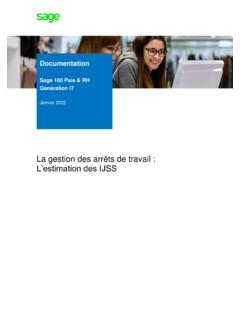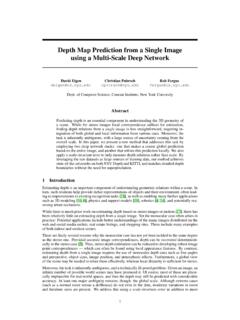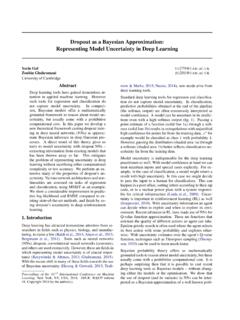Transcription of Age and Gender Classification using Convolutional Neural …
1 Age and Gender Classification using Convolutional Neural Networks Gil Levi and Tal Hassner Department of Mathematics and Computer Science The Open University of Israel Abstract Automatic age and Gender classification has become rel- evant to an increasing amount of applications, particularly since the rise of social platforms and social media. Nev- ertheless, performance of existing methods on real-world images is still significantly lacking, especially when com- pared to the tremendous leaps in performance recently re- ported for the related task of face recognition. In this paper we show that by learning representations through the use of deep- Convolutional Neural networks (CNN), a significant increase in performance can be obtained on these tasks.
2 To this end, we propose a simple Convolutional net architecture that can be used even when the amount of learning data is limited. We evaluate our method on the recent Adience benchmark for age and Gender estimation and show it to dramatically outperform current state-of-the-art methods. 1. Introduction Figure 1. Faces from the Adience benchmark for age and gen- Age and Gender play fundamental roles in social inter- der classification [10]. These images represent some of the actions. Languages reserve different salutations and gram- challenges of age and Gender estimation from real-world, uncon- mar rules for men or women, and very often different vo- strained images.
3 Most notably, extreme blur (low-resolution), oc- cabularies are used when addressing elders compared to clusions, out-of-plane pose variations, expressions and more. young people. Despite the basic roles these attributes play in our day-to-day lives, the ability to automatically estimate them accurately and reliably from face images is still far exploit the massive numbers of image examples and data from meeting the needs of commercial applications. This is available through the Internet in order to improve classifi- particularly perplexing when considering recent claims to cation capabilities.
4 Super-human capabilities in the related task of face recogni- In this paper we attempt to close the gap between auto- tion ( , [48]). matic face recognition capabilities and those of age and gen- Past approaches to estimating or classifying these at- der estimation methods. To this end, we follow the success- tributes from face images have relied on differences in fa- ful example laid down by recent face recognition systems: cial feature dimensions [29] or tailored face descriptors Face recognition techniques described in the last few years ( , [10, 15, 32]). Most have employed classification have shown that tremendous progress can be made by the schemes designed particularly for age or Gender estimation use of deep Convolutional Neural networks (CNN) [31].
5 We tasks, including [4] and others. Few of these past meth- demonstrate similar gains with a simple network architec- ods were designed to handle the many challenges of uncon- ture, designed by considering the rather limited availability strained imaging conditions [10]. Moreover, the machine of accurate age and Gender labels in existing face data sets. learning methods employed by these systems did not fully We test our network on the newly released Adience 1. benchmark for age and Gender classification of unfiltered Gaussian Mixture Models (GMM) [13] were used to rep- face images [10].
6 We show that despite the very challenging resent the distribution of facial patches. In [54] GMM were nature of the images in the Adience set and the simplicity of used again for representing the distribution of local facial our network design, our method outperforms existing state measurements, but robust descriptors were used instead of of the art by substantial margins. Although these results pixel patches. Finally, instead of GMM, Hidden-Markov- provide a remarkable baseline for deep-learning-based ap- Model, super-vectors [40] were used in [56] for represent- proaches, they leave room for improvements by more elab- ing face patch distributions.
7 Orate system designs, suggesting that the problem of accu- An alternative to the local image intensity patches are ro- rately estimating age and Gender in the unconstrained set- bust image descriptors: Gabor image descriptors [32] were tings, as reflected by the Adience images, remains unsolved. used in [15] along with a Fuzzy-LDA classifier which con- In order to provide a foothold for the development of more siders a face image as belonging to more than one age effective future methods, we make our trained models and class. In [20] a combination of Biologically-Inspired Fea- classification system publicly available.
8 For more infor- tures (BIF) [44] and various manifold-learning methods mation, please see the project webpage were used for age estimation . Gabor [32] and local binary il/home/hassner/projects/cnn_agegender. patterns (LBP) [1] features were used in [7] along with a hierarchical age classifier composed of Support Vector Ma- 2. Related Work chines (SVM) [9] to classify the input image to an age-class followed by a support vector regression [52] to estimate a Before describing the proposed method we briefly re- precise age. view related methods for age and Gender classification and Finally, [4] proposed improved versions of relevant com- provide a cursory overview of deep Convolutional networks.
9 Ponent analysis [3] and locally preserving projections [36]. Those methods are used for distance learning and dimen- Age and Gender Classification sionality reduction, respectively, with Active Appearance Age classification. The problem of automatically extract- Models [8] as an image feature. ing age related attributes from facial images has received All of these methods have proven effective on small increasing attention in recent years and many methods have and/or constrained benchmarks for age estimation . To our been put fourth. A detailed survey of such methods can be knowledge, the best performing methods were demon- found in [11] and, more recently, in [21].
10 We note that de- strated on the Group Photos benchmark [14]. In [10]. spite our focus here on age group classification rather than state-of-the-art performance on this benchmark was pre- precise age estimation ( , age regression), the survey be- sented by employing LBP descriptor variations [53] and a low includes methods designed for either task. dropout-SVM classifier. We show our proposed method to Early methods for age estimation are based on calcu- outperform the results they report on the more challenging lating ratios between different measurements of facial fea- Adience benchmark, designed for the same task.







